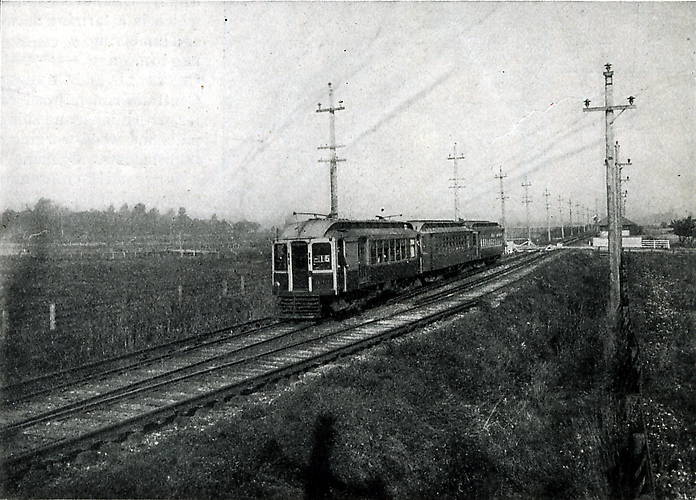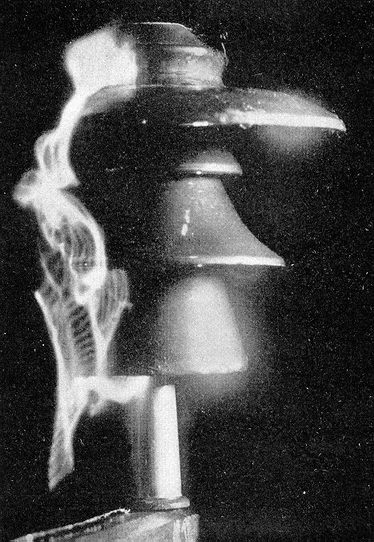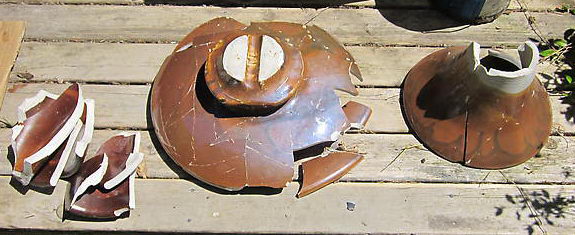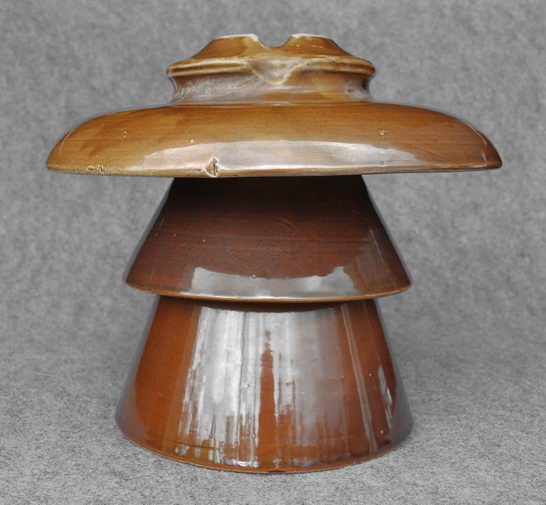
Fred Locke
Multipart Porcelain Insulators
(page 6 of 6)
Go to Main Page
Go to Multipart History Page 1 Page 2 Page 3 Page 4 Page 5 Page 6
Click on the links below to view each style:
M-4321
(Locke catalog #341)
Production date:
M-4325
(Locke catalog #351)
Production date: 1903
M-4325 was the worlds first four-part cemented multipart insulator and also the very first "lily-shell" design . It was produced in 1903 by Fred M. Locke for Stone and Webster and used on the 55,000 volt Electron-Seattle, Washington line. This was a special custom ordered design for the Stone and Webster engineering firm for the construction this line. 3000 were produced for this order in the spring of 1903. In subsequent years, this design was very popular and used throughout North America. M-4325 was later produced by the hundreds of thousands made to the exacting detail of Stone and Webster's drawing. This style was cataloged by every manufacturer in the 1905-1925 era. The Fred Locke insulators shown below were only in service from 1904-1915. The one with the #6-1 marking is the first complete unit seen by any living person today. All of them were destroyed and removed from service by about 1918 because the fragile thin top skirts were very prone to cracking from cement expansion and electrical puncture.

This early photo from circa 1904-1906 of the Puget Sound Electric Raiway was taken near Pacific, WA. The poles on the right are of the Electron-Seattle 55 kV line that was once insulated with a mix of Fred Locke and Thomas M-4325's. [click here] The line on the left constructed in 1902 is insulated with Fred Locke M-2785's .[click here] these were replaced around 1917 with Pittsburg made M-4325's. This line ran parallel to the interurban for it's entire length and provided power for the line's substation.
The insulator became known as the Stone and Webster insulator in engineering circles of the time. A trade journal article from 1917 written by an engineer for Puget Sound Power Light and Traction Company stated that 90% of the original Fred Locke insulators had failed in service due to cement expansion cracking of the thin top skirts. All of the Fred Locke M-4325's were replaced by M-4325's made by another manufacturer, which were trouble free.
Mike Spadafora found the only two kitsulator specimens that have ever been recovered from the line. One has the #6-1 marking and the other #7-1 marking.

M-4325 with #6-1 marking. Right is Fred Locke M-4325 under electrical test (AIEE 1907).

M-4325 with #7-1 marking.
M-4384
(Locke catalog #360)
Production date:
The M-4384 was introduced
in late 1903 or early 1904. It was designed by engineers of the California Gas
and Electric Co (later PG&E) for use in the upgrading of the original
Colgate and Electra lines to 60 kV the basic design seems to have been derived
from the M-3725 by adding a fourth recessed inner skirt. The insulator was
fabulously successful and thousands were put into service in northern
California. Many survived to modern
times fatefully doing their job insulating PG&E's older 60 kV lines mainly
in the central valley of California, a few remain in service as of this writing
including some that may be marked with Fred Locke markings.
Two variations of this insulator exist One made in a three part mold
which are likely the earlier production and some made by green trimming which
have no mold line visible both variations come with or without marking #7-1 the
colors tend to be very pretty medium to light tan sometimes verging on blond.
Overall, these were the most successful and long lasting insulators that Fred
Locke produced.
M-4384's were also used to replace M-2795's on the Bay Counties and Standard Electric lines. It has a recessed 4th skirt. Some specimens have the #7-1 marking, but many are unmarked.


M-4384 with #7-1 marking.
Go to Multipart History Page 1 Page 2 Page 3 Page 4 Page 5 Page 6
Go to Main Page